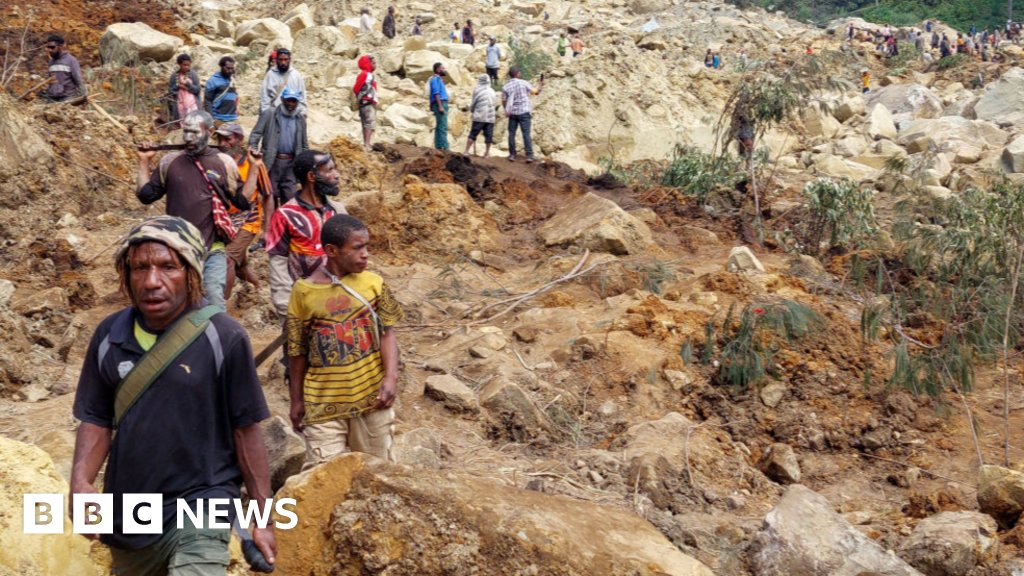More than 2,000 people are feared to have been buried alive by a massive landslide that engulfed a village and a work camp in Papua New Guinea’s remote northern highlands. The landslide struck early Friday morning, around 3 a.m. local time, in the densely populated region of Enga Province, an area known for its challenging jungle terrain and proximity to the Porgera gold mine operated by Barrick Gold and Zijin Mining.

Also Read: Crows Can Count One to Four, Study Reveals
Initial reported a death toll of a few dozen which quickly escalated to 670. Current figures suggest that over 2,000 individuals are still buried under the rubble.
The landslide resulted in the destruction of buildings, food gardens, and infrastructure. Large boulders, some the size of shipping containers have cut off major highways, complicating rescue efforts.
The main highway to the disaster site is blocked hindering the movement of heavy equipment and rescue teams.
Unstable ground conditions with water flowing beneath the rocks continue to pose dangers to rescue workers and survivors.
Initial aid convoys reached the area with tarps and water but lacked essential supplies like food. The local government has since secured food and water for approximately 600 people, but heavy machinery necessary for large-scale rescue operations remains inaccessible.
The U.N.’s International Organization for Migration (IOM) has been closely monitoring the situation. Anne Mandal, a spokesperson for the IOM, highlighted the necessity for international support to tackle further losses and provide aid to the affected population.
The region had already been experiencing tribal conflicts. Over 250 houses have been abandoned due to fears of additional landslides, displacing roughly 1,250 people.
The White House has expressed condolences with President Biden stating, “Jill and I are heartbroken by the loss of life and devastation caused by the landslide in Papua New Guinea.”
While the exact cause of the landslide remains unclear, experts suggest heavy rainfall and unstable geological conditions as primary factors.
Frequent earthquakes in the region contribute to the instability of steep slopes, potentially triggering such disasters.
Deforestation may have exacerbated the landslide’s impact by removing vegetation that stabilizes the soil. Alan Collins, a geology professor at the University of Adelaide noted that tree roots has been the cause in preventing landslides by maintaining soil integrity.
Luseta Laso Mana, the acting director of Papua New Guinea’s National Disaster Center reported to the United Nations that the landslide “buried more than 2,000 people alive.”
Also Read: Top 10 Countries for Travel and Tourism, According to WEF
This estimate revealed in a letter dated Sunday, highlights the scale of the disaster and the need for international support.
The United Nations through its International Organization for Migration (IOM) initially estimated the death toll to be around 670.
This figure was based on local calculations from Yambali village and Enga provincial officials, who determined that over 150 homes had been buried.
The initial estimate had considered 60 homes buried, lower than the current numbers being discussed.
The disaster struck a remote part of the country, complicating rescue and recovery efforts. The village’s isolated location and lack of telecommunications have hindered the collection of accurate data.
Ongoing tribal warfare in the province has complicated the situation. International relief workers and aid convoys require military escorts to navigate the region safely.
The landslide destroyed buildings, food gardens, and a 200-meter stretch of the province’s main highway, buried under 6 to 8 meters of debris. This highway is a critical link to the Porgera Mine, an essential part of the country’s economic infrastructure.
An excavator, donated by a local builder became the first piece of heavy earth-moving machinery to arrive at the site.
Until then, villagers had been using shovels and farming tools to search for bodies during the shifting debris.
Mana and Papua New Guinea’s Defense Minister, Billy Joseph visited Yambali via an Australian military helicopter.
Their firsthand observation aimed to assess the needs and determine the level of international support required.
During the visit, Mana’s office provided a check for 500,000 kina ($130,000) to a local official to procure emergency supplies for the 4,000 displaced survivors.
Also Read: Papua New Guinea: More than 100 Feared Dead in Massive Landslide




















